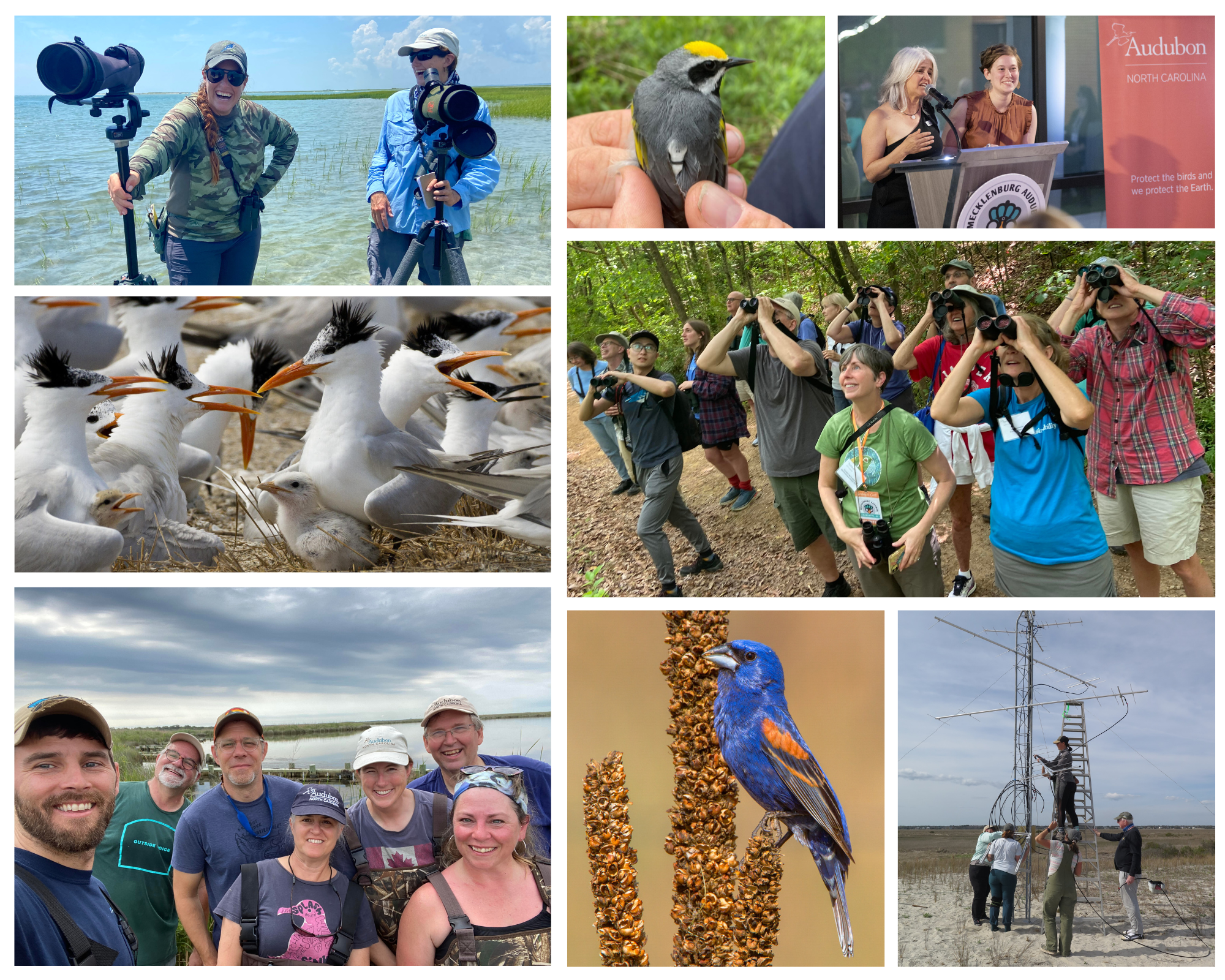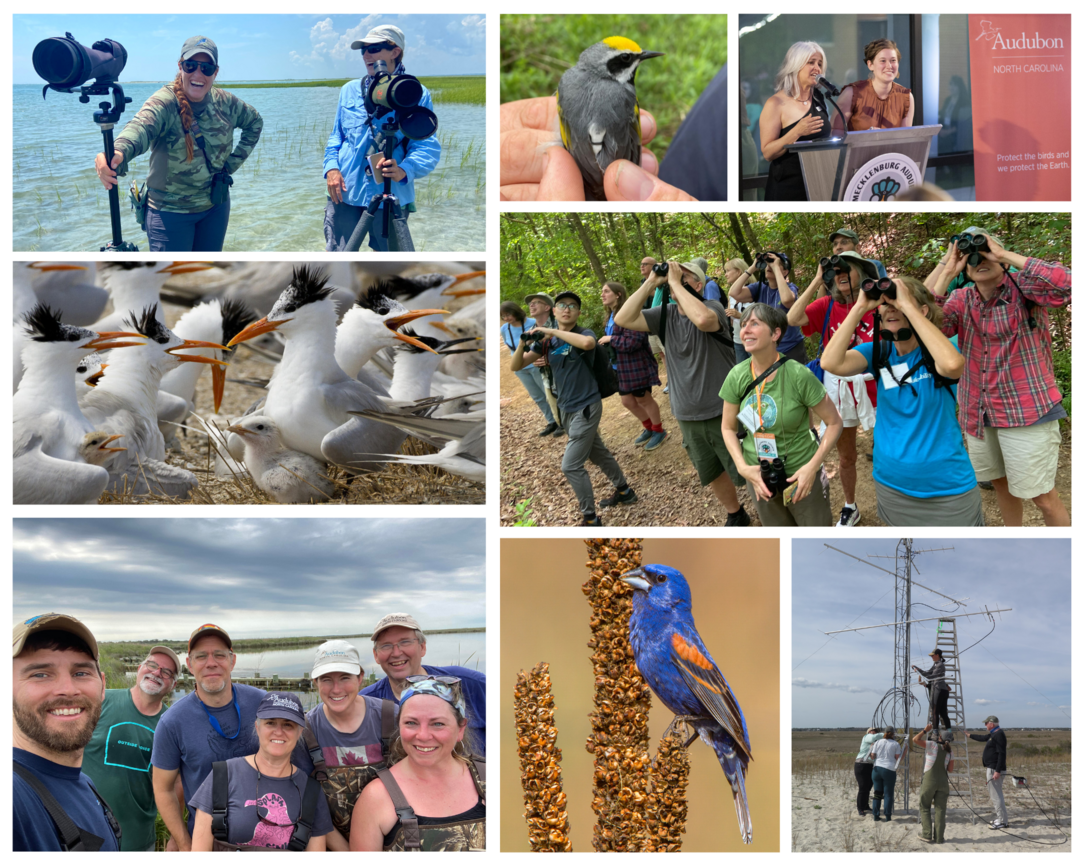From remote barrier islands to city halls across the state, Audubon and our members stepped up to protect birds in new and important ways this year.
We initiated new research on sensitive species, launched habitat restoration projects from the Outer Banks to the Cape Fear River, and, along with our chapters, spoke up at town halls and the state legislature to advance policies for birds.
This work wouldn’t be possible without our network of chapters and supporters. Read on for a recap of our biggest wins for birds in 2023.
We launched projects to restore habitat from the Outer Banks to the Cape Fear River
Thanks to two NC Land and Water Fund grants totaling more than $400,000, Audubon launched new projects to protect and restore important bird habitat at our Pine Island Sanctuary on Currituck Sound and at Battery Island in the Cape Fear River. The projects will both improve habitat and provide storm protection and water quality benefits for people.
At Pine Island, we'll be restoring a pond and stream system at the heart of the sanctuary and reconnecting degraded habitat to the sanctuary’s marshes. Ultimately, the project will improve the resilience of an ecosystem already at risk and create important habitat for rails, wading birds, and marsh-dependent sparrows. At Battery Island, we'll be studying the best strategies to fight erosion at this critical nesting sanctuary near the mouth of the river, home to as many as 10,000 pairs of nesting White Ibis each spring and summer.
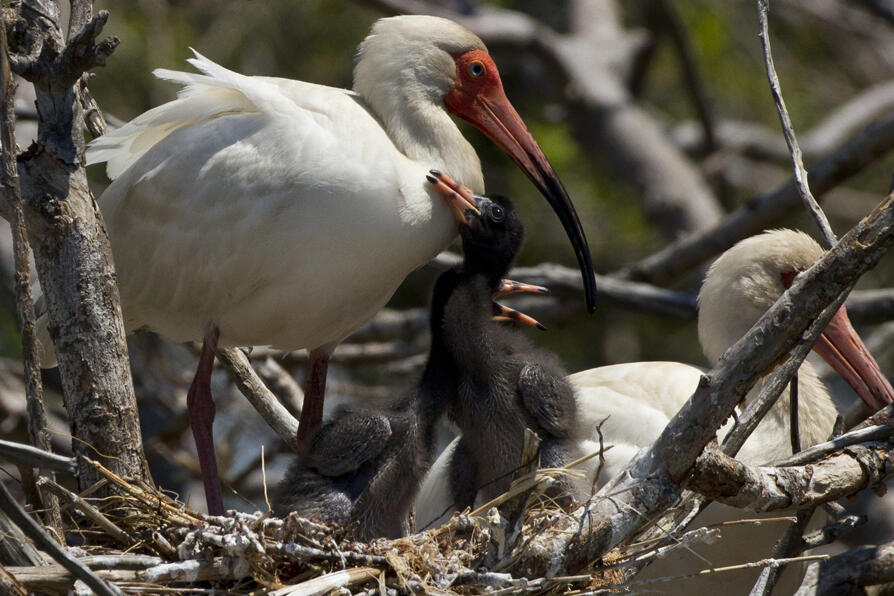
Together with Audubon chapters, we grew our grassroots power and helped pass Lights Out programs across the state
This year our members spoke up for birds from town halls to the state legislature and beyond. As a direct result, we’re seeing major progress on climate and conservation, as well as local policy changes that protect birds in our communities and grow our long-term grassroots political power.
In the last year, Audubon chapters helped pass a wave of new programs in cities across the state to make our night skies darker and safer for migrating birds. Thanks to our chapters, cities that have adopted Lights Out programs in the last year include Raleigh, Greensboro, Asheville, Chapel Hill, and Matthews.
At our annual Advocacy Day in June, 76 Audubon members rallied at the General Assembly and met with half of all Senators and a third of House members. We supported a pair of bird-friendly bills focused on native plants (Senate Bill 628) and heirs property (House Bill 367). Together, we laid a strong foundation for these bills and will be taking them up again in the New Year.

We restored a critical nesting island in the Cape Fear River
This spring, Audubon partnered with the U.S. Army Corps of Engineers to renourish the severely eroded Ferry Slip Island in the Cape Fear River with dredged sediment, nearly doubling its size. Now, Ferry Slip Island is providing the kind of sandy habitat that beach-nesting birds need to raise their young and rest during their long migratory journeys. In the wake of the project this summer, the island hosted the first pair of Black Skimmers to nest on the river in a decade.
With our partners, we launched a first-of-its kind of study on Golden-winged Warblers using tiny tracking devices
In southern Appalachia, Golden-wing warbler populations have declined as much as 98 percent since 1966. In an effort to provide full lifecycle protections for this rare songbird, Audubon North Carolina and partners across the South and Midwest are using radio tags to track their movements.
This summer, we outfitted seven warblers with nanotag tracking devices, which send out radio signals that are picked up by Motus wildlife tracking radio towers. Two of our birds were detected in Florida this fall on their way to South America for the winter. This data will give researchers a never-before-seen look into the movements and migratory patterns of this rare songbird and support actions we can take to protect them.
We grew support for responsible offshore wind energy and repealed a serious roadblock
Offshore wind energy is a critical tool in the fight against climate change, and North Carolina has more potential than any state on the Atlantic Seaboard. In the last year, Audubon members helped advocate for the industry to grow responsibly, to protect birds and reduce emissions, and scored several important victories.
We helped grow bipartisan support to reverse a federal moratorium on new offshore wind energy leases, instituted by the previous administration in Washington D.C. The moratorium, which would have lasted 10 years, was ultimately reversed by a provision added to the Inflation Reduction Act by North Carolina Congresswoman Deborah Ross.
Audubon members also took action during two critical public comment hearings for the Wilmington East Wind Energy Area, accounting for 95% percent of all comments submitted. Early results of these efforts are encouraging—The Bureau of Ocean Energy Management included strong wildlife monitoring requirements in its leases. Audubon is also a founding member of the Offshore Wind for North Carolina Coalition, which has helped lay the groundwork for responsible growth in the state.
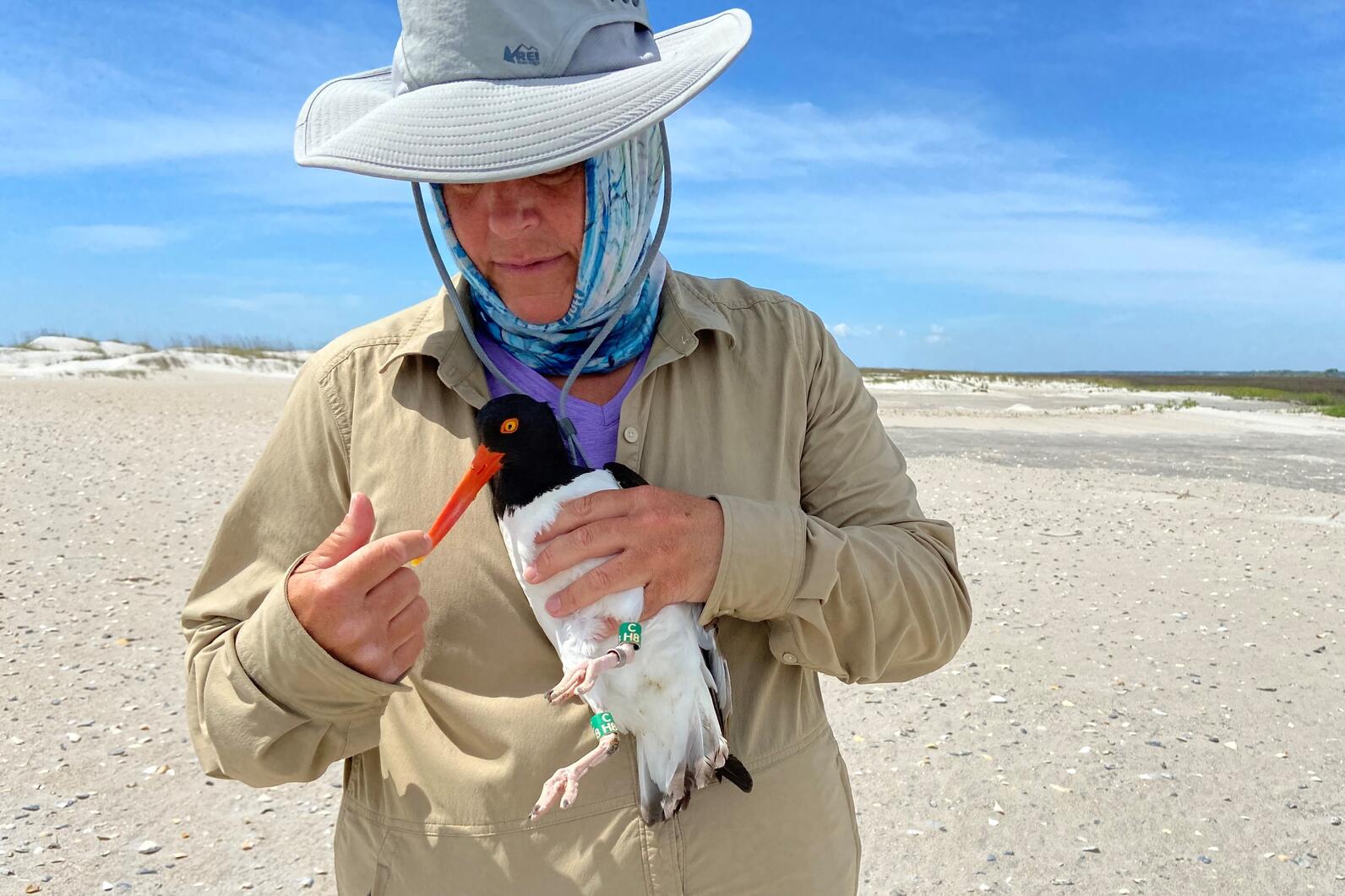
We launched new coastal bird research, all while continuing to protect 40 percent of North Carolina’s coastal nesting waterbirds
Audubon and our partners have begun a new predator control study examining whether ghost crab management can help reduce the impact they have on oystercatcher nests. We also completed the second year of our American Oystercatcher datalogger project, tracking the fine-scale movements of this iconic coastal species.
Meanwhile, our biologists continued their on-the-ground management of our nesting sanctuaries, which stretch from Pamlico Sound to the Cape Fear River. Nesting coastal birds faced a number of challenges, including early storms and persistent predation. Some colonies rebounded to fledge a large number of chicks, others did just so-so. All told, our staff and the sanctuary system they manage provide safe breeding grounds for 40 percent of North Carolina’s coastal nesting birds, from plovers to pelicans.
We tested techniques to create habitat for critically threatened Eastern Black Rail at our Pine Island Sanctuary
Prescribed burns are important to the conservation of birds and wildlife living at our Pine Island Sanctuary. The process mimics the natural renewal cycle created when lightning strikes set the marsh grass ablaze. At the sanctuary, Audubon is testing whether fire can be used as a tool to improve habitat for the federally threatened and ultra-secretive Eastern Black Rail.
Our partners, including the North Carolina Wildlife Resources Commissions, are using prescribed burns in neighboring parts of the coast where Black Rails are more established as a technique to improve habitat for this species. Annual Secretive Marsh Bird Surveys will help determine if these management practices are proving successful. We also received funding from the North American Wetlands Conservation Act funding program, in partnership with the Coastal Land Trust, to add irrigation to one of our impoundments at Pine Island, with the goal of attracting rails back to that portion of the property.
We grew our Working Lands program to reach new landowners and celebrated 15 years of the Forest Landbird Legacy Project
Our Working Lands program grew to new heights this year. To date, we have promoted bird- and climate-friendly forestry management to over 3,000 landowners, managers, and foresters that now have the tools to support birds and their habitat, bringing the total size of impacted forested lands to 60,000 acres.
The Forest Landbird Legacy Project is a major part of this work, and this year we celebrated 15 years of outreach and partnership with landowners who have committed to using sustainable land management methods that benefit birds and people alike.
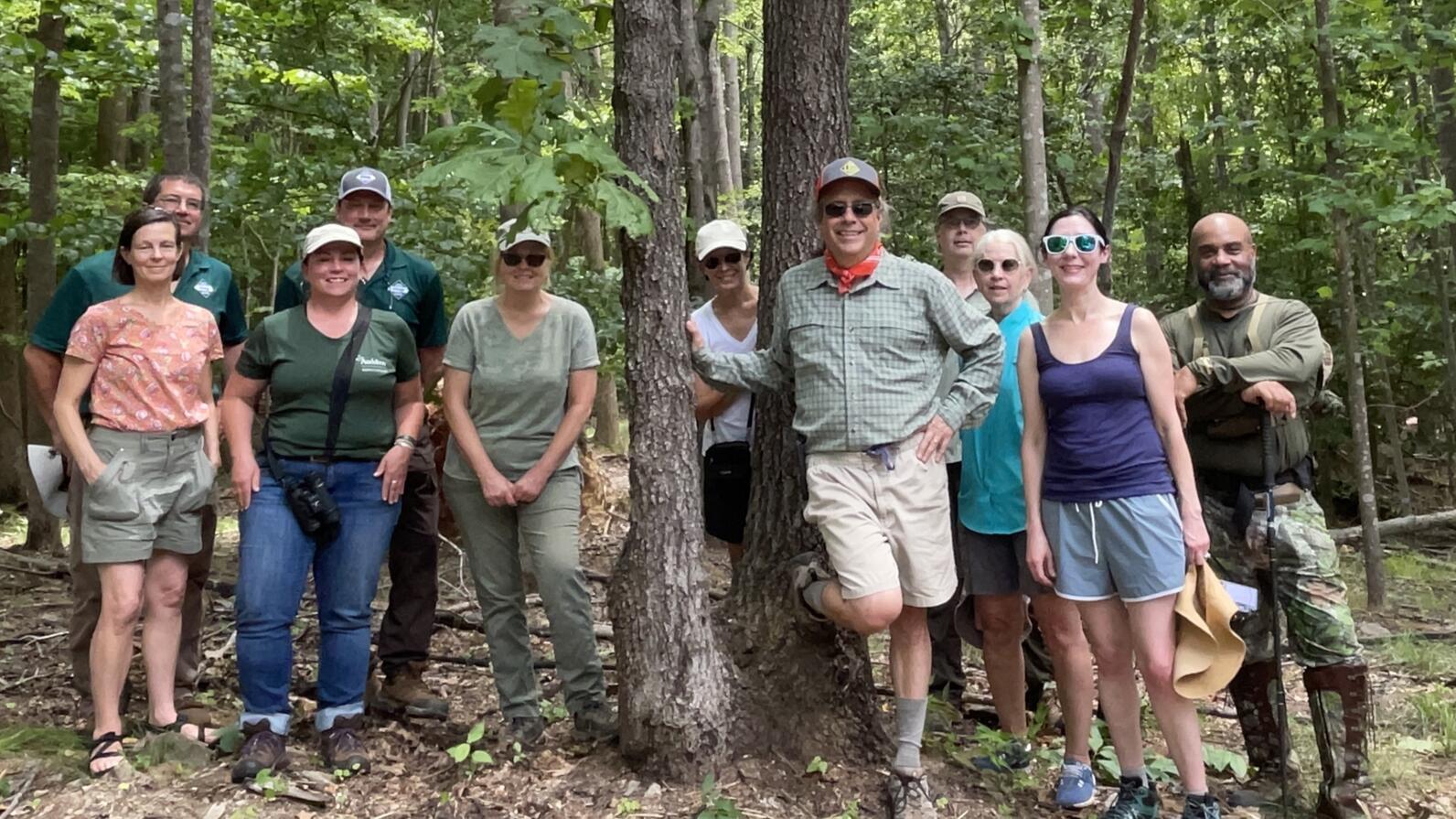
With Cape Fear Audubon, we installed a new Motus tower at our Lea Island Sanctuary
We partnered with Cape Fear Audubon and UNC Wilmington’s Danner Lab to install a new Motus tower at Lea Island north of Wilmington. The tower will help track migratory birds on the North Carolina coast, and has already revealed a new shorebird connection—three of the first four birds detected by the tower this summer traveled from the same remote Canadian wetland and had been tagged by the same researcher last spring. Since then, 24 birds representing 13 species have been detected, including Bank Swallow, Bobolink, and Gray Catbirds. With the Lea Island tower now operational, we have begun raising funds to install another tower on the northern coast at our Pine Island Sanctuary.
We continued building broad support for nature-based solutions in Currituck Sound
After three years of coalition building, Audubon began implementation of the Currituck Sound Coalition Marsh Conservation Plan. We met with seven partner groups from Virginia to discuss nature-based solutions across the region, secured funding to monitor sediment dynamics and shoreline change in Currituck Sound’s marshes with academic partners at UNC Chapel Hill, Elizabeth City State University, and East Carolina University, and completed our second year of secretive marsh bird surveys at our Pine Island Sanctuary.

